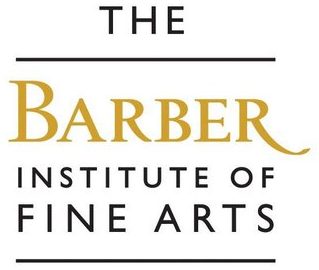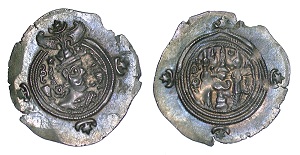Sasanian Coins
Who were the Sasanians?
Prior to the rise of Islam in the seventh century, the power which most effectively matched the Byzantine Empire in the east was the Sasanian Persian Empire, based around the areas of modern Iran and Iraq, and centred on its capital city of Ktesiphon, near modern Baghdad.
In 224 CE, Ardashir, the son or grandson of a Zoroastrian priest named Sasan defeated the old Arsacid (or Parthian) Emperor Ardavan IV, and began 400 years of his dynasty’s rule over the Persian Empire until the rise of Islam and the defeat of the final Sasanian Emperor, Yazdgird III, in 651 CE. The Sasanian emperors produced a large amount of silver coins, called drachms (pronounced ‘drams’), of which the Barber has the second largest public collection in the UK.
Types of Sasanian Coins
Under the Arsacid rulers, Iranian coins had used Greek script, which had become the lingua franca of the Middle East in the wake of the conquests of Alexander III of Macedon (Alexander the Great), though they had usually carried an image of the seated archer common on the coins of the Achaemenid emperors before them. The coins of the Sasanian emperors were much more obviously Persian, using the Middle Persian script called Pahlavi, and emphasising the Zoroastrian religion.
The reverse of all Sasanian drachms carried an image of an ateshtan, a ‘fire altar’, sometimes flanked by incense burners, sometimes flanked by attendants. These attendants are usually depictions of Magi, Zoroastrian priests, but sometimes one is the Emperor himself. It is a common misconception that Zoroastrians worship the fire itself, but it is in fact through the holy flame specifically that they communicate with and come to know God, called Ahura Mazda. In this way, the presence of the ateshtan on the reverse of the coins of the Sasanian Empire is similar to the presence of the cross on the reverse of the coins of the Sasanians’ great rivals, the Late Roman/Byzantine Empire.
The obverse of the Sasanian drachms always contain the bust of the Emperor, who was called the Shahanshah, meaning king-of-kings. Each emperor had his own distinct and personalised crown, where different aspects of the crown represented different aspects of kingship – wings for victory, ribbons for glory, the korymobos (a silk sack holding the hair above the head) for manliness, the moon for piety, and so on.
Sasanian drachms were also some of the first truly flat coins to be produced, marking the numismatic transition from the ancient world with its chunky, thick-flan coins, to the Mediaeval, with its wafer-thin coins. It is generally thought that this was done to help prevent forgery. A great many ancient coins were base metal cores plated with gold or silver; by increasing the surface area to volume ratio, the Sasanians made this practice much less viable for the forgers, as they would need much more precious metal, and therefore more expensive, to make the counterfeits.
While the Sasanians did produce gold and base metal coins, they were excessively rare.
The wider significance of Sasanian coins
Sasanian drachms were globally significant, being the coinage upon which the Caliphal dirham was later based, as well as numerous coinages from the Indian region and Central Asia.
The Barber’s collection
The Barber Institute holds around 1,000 Sasanian coins and just over 200 Sasanian-adjacent coins, making it an internationally significant Sasanian coin collection and the second largest public collection in the UK after the British Museum. The focus of the collection is seventh century, which comprises around half of the section, reflecting a similar seventh-century bias in the Byzantine coinage in the collection (comprising around a quarter of the Byzantine section of the collection).
A collection highlight
S0526 – A gold dinar of Khusrau II
This unusual gold dinar is believed to have been struck to commemorate the Sasanian capture of Jerusalem from the Byzantine Empire in 613 CE, as this is the date the coin gives us in the Pahlavi inscription on the reverse. On the reverse is the bust of the Shahanshah, Khusrau II, with his personal crown. The frontal facing bust on the obverse is an uncertain figure. Some scholars believe that this is a representation of the Yazata Anahita, whose cult was overseen in Fars by Sasan, the semi-legendary ancestor of the Sasanian Emperors. Her divinity is signified by the flames behind her head, though she was the Yazata associated with water.
Discover the collection online
All of the Barber’s Sasanian coins are available online. Below is a clickable list of emperors which will link you to our online catalogue pages for them and their coins.
- Artashir I (224-242)
- Shapur I (242-270)
- Hormazd I (270-271)
- Varhran I (271-274)
- Varhran II (274-293)
- Varhran III (293) – No coins known
- Narseh (293-302)
- Hormazd II (302-309)
- Adhur Narseh (309) – No coins known
- Shapur II (309-379)
- Artashir II (379-383)
- Shapur III (383-388)
- Varhran IV (388-399)
- Yazdgird I (399-420)
- Varhran V (420-438)
- Yazdgird II (438-457)
- Hormazd III (457-459) – No coins known
- Peroz I (459-484)
- Valkash (484-488)
- Kavadh I, 1st reign (488-496)
- Zamasp (496-498)
- Kavad I, restored (498-531)
- Khusrau I (531-579)
- Hormazd IV (579-590)
- Khusrau II, 1st reign (590)
- Varhran VI Chobin (590-591)
- Khusrau II, restored (591-628)
- Vistahm (rebel 591-596)
- Kavad II (628)
- Artashir III (628-630)
- Shahrvaraz (630) – No coins in the collection
- [The period 630-631 is said to contain a number of Emperors, only some of whom have ‘identified’ coins.]
- Bouran (c.630-631)
- Azarmidokht (c.630-631) – No coins in the collection
- Hormazd V (c.631-632)
- Khusrau V (c.632)
- Yazdgird III (632-651)
Exhibitions
In 2019-2020, the exhibition A Tale of Two Empires: Rome and Persia explored the Sasanian coinages of Shapur I, Yazdgird I and Khusrau II alongside their Roman counterparts, Valerian, Theodosius II and Herakleios. The exhibition is no longer open.
Visiting the collection
To visit the Sasanian collection, you will need to book an appointment to our Coin Study Room. Details on arranging a visit can be found for individuals looking to research (this includes both affiliated and independent scholars), or to book for a group visit for both schools and the general public.
For researchers, our dedicated coin library holds up-to-date books on Sasanian coinage, such as the ongoing SNS volumes, as well as older scholarship, such as Paruck, which can be consulted alongside the coins.

